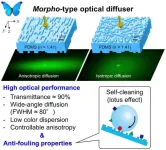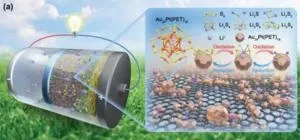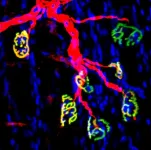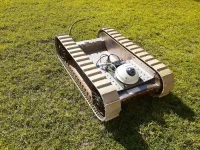(Press-News.org)
Osaka, Japan – As you watch Morpho butterflies wobble in flight, shimmering in vivid blue color, you’re witnessing an uncommon form of structural color that researchers are only beginning to use in lighting technologies such as optical diffusers. Furthermore, imparting a self-cleaning capability to such diffusers would minimize soiling and staining and maximize practical utility.
Now, in a study recently published in Advanced Optical Materials, researchers at Osaka University have developed a water-repelling nanostructured light diffuser that surpasses the functionality of other common diffusers. This work might help solve common lighting dilemmas in modern technologies.
Standard lighting can eventually become tiring because it’s unevenly illuminating. Thus, many display technologies use optical diffusers to make the light output more uniform. However, conventional optical diffusers reduce the light output, don’t work well for all emitted colors, or require special effort to clean. Morpho butterflies are an inspiration for improved optical diffusers. Their randomly arranged multilayer architecture enables structural color: in this case, selective reflection of blue light over a ≥±40° angle from the direction of illumination. The goal of the present work is to use this inspiration from nature to design a simplified optical diffuser that has both high transmittance and wide angular spread, works for a range of colors without dispersion, cleans by a simple water rinse, and can be shaped with standard nanofabrication tools.
“We create two-dimensional nanopatterns—in common transparent polydimethylsiloxane elastomer—of binary height yet random width, and the two surfaces have different structural scales,” explains Kazuma Yamashita, lead author of the study. “Thus, we report an effective optical diffuser for short- and long-wavelength light.”
The researchers tailored the patterns of the diffuser surfaces to optimize the performance for blue and red light, and their self-cleaning properties. The experimentally measured light transmittance was >93% over the entire visible light spectrum, and the light diffusion was substantial and could be controlled into anisotropic shape: 78° in the x-direction and 16° in the y-direction (similar to values calculated by simulations). Furthermore, the surfaces both strongly repelled water in contact angle and self-cleaning experiments.
“Applying protective cover glass layers on either side of the optical diffuser largely maintains the optical properties, yet protects against scratching,” says Akira Saito, senior author. “The glass minimizes the need for careful handling, and indicates our technology’s utility to daylight-harvesting windows.”
This work emphasizes that studying the natural world can provide insights for improved everyday devices; in this case, lighting technologies for visual displays. The fact that the diffuser consists of a cheap material that essentially cleans itself and can be easily shaped with common tools might inspire other researchers to apply the results of this work to electronics and many other fields.
###
The article, “Development of a high-performance, anti-fouling optical diffuser inspired by Morpho butterfly's nanostructure,” was published in Advanced Optical Materials at DOI: https://doi.org/10.1002/adom.202301086
About Osaka University
Osaka University was founded in 1931 as one of the seven imperial universities of Japan and is now one of Japan's leading comprehensive universities with a broad disciplinary spectrum. This strength is coupled with a singular drive for innovation that extends throughout the scientific process, from fundamental research to the creation of applied technology with positive economic impacts. Its commitment to innovation has been recognized in Japan and around the world, being named Japan's most innovative university in 2015 (Reuters 2015 Top 100) and one of the most innovative institutions in the world in 2017 (Innovative Universities and the Nature Index Innovation 2017). Now, Osaka University is leveraging its role as a Designated National University Corporation selected by the Ministry of Education, Culture, Sports, Science and Technology to contribute to innovation for human welfare, sustainable development of society, and social transformation.
Website: https://resou.osaka-u.ac.jp/e
END
WASHINGTON (Oct. 12, 2023) – Patients and oncologists are supportive of complementary therapies, such as nutrition counseling, exercise, massage, and mediation, for cancer treatment, according to a new survey conducted on behalf of the Healing Works Foundation. However, a disconnect exists between this growing interest and oncologists’ perceptions of patient support. One-third of oncologists said their patients lack interest in these therapies, but only 13% of cancer patients cite lack of interest when asked ...
UNIVERSITY PARK, Pa. — Farmers are used to growing crops and producing other goods, but a new study led by Penn State researchers suggests the social media platform TikTok may help them cultivate something new: empathy around the issue of climate change.
The researchers published their work in the Journal of Rural Studies.
The team, who analyzed responses to climate change TikToks posted by farmers, found that many people responded to the videos with warmth and compassion, signaling emotional empathy.
However, the researchers also found that the videos were not as successful at triggering cognitive empathy ...
EX-Fusion Inc. (CEO: Kazuki Matsuo, hereinafter referred to as "EX-Fusion") has established a Collaborative Research Cluster focused on advancing liquid metal devices (Terminology 1) for the realization of commercial laser fusion reactors (Figure1, Terminology 2) in collaboration with Tokyo Institute of Technology (President: Kazuya Masu, hereinafter referred to as "Tokyo Tech"). The signing ceremony to formalize this partnership was held on October 11, marking the official commencement of their joint efforts.
The ‘EX-Fusion Liquid Metal Collaborative Research Cluster’ has been established with the support of the Tokyo Tech's Open Innovation Platform. ...
The massive 2015 flooding of the Sagavanirktok River in northern Alaska had immediate impacts, including closure of the Dalton Highway for several days, but it also contributed to longer-term ground subsidence in the permafrost-rich region.
That’s the finding by assistant professor Simon Zwieback at the University of Alaska Fairbanks Geophysical Institute in a study published Sept. 27 by the journal Permafrost and Periglacial Processes.
Zwieback is the paper’s lead author. UAF scientists Mikhail Kanevskiy, Donald Walker, Vladimir ...
A new study, jointly conducted by the University of Adelaide and University of Essex, has found that renting, rather than owning, a private-sector home leads to faster biological ageing.
The negative health impacts of renting were shown to be greater than those of experiencing unemployment or being a former smoker.
“Our findings demonstrate that housing circumstances have a significant impact on biological ageing, even more so than other important social determinants, such as unemployment, for example, and therefore health impacts should be an important consideration shaping housing policies,” ...
Scientists at Stanford University School of Medicine and Sanford Burnham Prebys have demonstrated a new way to accelerate recovery from peripheral nerve injury by targeting an enzyme that was thought to be responsible for muscle wasting with aging.
Damage to the peripheral nervous system (the nerves that form the communications network between the brain, spinal cord and body) is debilitating; the effectiveness of physiotherapy as treatment is limited. Whether from trauma, disease or aging, nerve function declines and/or is lost, resulting in diminished strength and even paralysis.
In ...
Australian researchers have designed an algorithm that can intercept a man-in-the-middle (MitM) cyberattack on an unmanned military robot and shut it down in seconds.
In an experiment using deep learning neural networks to simulate the behaviour of the human brain, artificial intelligence experts from Charles Sturt University and the University of South Australia (UniSA) trained the robot’s operating system to learn the signature of a MitM eavesdropping cyberattack. This is where attackers ...
Researchers at Monash University have identified a new way of mapping ‘phosphenes’ – the visual perception of the bright flashes we see when no light is entering the eye – to improve the outcome of surgery for patients receiving a cortical visual prosthesis (‘bionic eye’).
Cortical visual prostheses are devices implanted onto the brain with the aim of restoring sight by directly stimulating the area responsible for vision, the visual cortex, bypassing damage to the retina of ...
UNIVERSITY PARK, Pa. — A civics test policy mandated in 18 states that focuses on rote memorization and testing of political knowledge did not improve youth voter turnout as intended, according to Penn State College of Education researchers. As an alternative, they recommend a thorough integration of practical information on the voter registration process within social studies curricula.
“Providing students opportunities to really engage with what leadership means, having discussions and debates with leaders and politicians, mock elections… ...
A small molecule previously shown to enhance strength in injured or old laboratory mice does so by restoring lost connections between nerves and muscle fibers, Stanford Medicine researchers have found.
The molecule blocks the activity of an aging-associated enzyme, or gerozyme, called 15-PGDH that naturally increases in muscles as they age. The study showed that levels of the gerozyme increase in muscles after nerve damage and that it is prevalent in muscle fibers of people with neuromuscular diseases.
The research is the first to show that damaged motor neurons — nerves connecting the spinal cord to muscles — can be induced to regenerate ...




